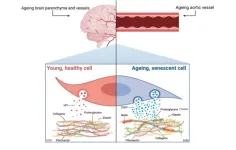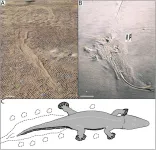(Press-News.org) Nearly one in five American adults has diabetes. But that doesn’t mean the common condition is simple to treat or manage. Diabetes and its complications are the No. 1 cause of kidney failure, adult blindness, and lower-limb amputations. It’s also the seventh-leading cause of death in the U.S. As with so many chronic conditions, diabetes also disproportionately affects the most vulnerable in our communities, further exacerbating existing health disparities.
In a new supplemental issue of the Journal of General Internal Medicine released March 28, physicians at the University of Chicago Medicine and colleagues nationwide are publishing the results of the Bridging the Gap: Reducing Disparities in Diabetes Care Initiative, a five-year multisite initiative funded by the Merck Foundation, aimed at addressing those disparities in diabetes care and outcomes across the country. Building holistic care systems to address individual medical and social care needs — along with policy changes that affect community resources and payment systems — can improve diabetes care and management, and improve health outcomes for many marginalized patient populations.
Now, as they report out the final outcomes of their five-year effort, the team is sharing what has been the most successful for improving outcomes. First, holistic, team-based care that bridges clinic treatment to community resources. This builds a trust-based relationship between clinicians and their patients and is tailored according to a patient’s severity and needs.
Second, healthcare organizations that partner with community groups to address social factors such as food insecurity. This can expand care beyond the walls of a medical clinic and empower patients to better manage their own symptoms with community support. And finally, adjusting policy and payment systems to support and incentivize prevention and addressing unmet social needs like food access or housing improves outcomes. This reduces complications and improves overall care for patients.
Collaborators have built evidence-based holistic care systems to address diabetes care on a population level. This includes programs and partnerships to address challenges faced by marginalized communities that can increase risk of diabetes complications, such as access to healthy food and secure housing, in addition to addressing healthcare challenges for individual patients.
“Diabetes is a poster child for chronic illness,” said Marshall Chin, MD, MPH, Richard Parrillo Family Distinguished Service Professor of Medicine at UChicago Medicine. “The principles we have identified and developed with this project apply to many other diseases, and could have a dramatic effect on population health and healthcare costs.”
UChicago was selected by the Merck Foundation in 2017 as the National Program Office for the Bridging the Gap: Reducing Disparities in Diabetes Care Initiative. It collaborates with eight grantees, the grantees’ partner organizations, and the Merck Foundation to develop innovative ways to address disparities in diabetes care and outcomes. Beyond UChicago Medicine, other participating institutions included:
Alameda County Public Health Department – Oakland, CA
La Clínica del Pueblo – Washington, DC
Marshall University – Huntington, WV
Minneapolis Health Department – Minneapolis MN
Providence Health & Services – Portland, OR
Trenton Health Team – Trenton, NJ
St. Mary’s Health and Clearwater Valley Health – Orofino, ID
UPMC Western Maryland – Cumberland, MD
This cooperative system allowed healthcare organizations, community partners, public health leaders, researchers, clinicians and other healthcare professionals at the various institutions to work together toward shared solutions.
“This project has essentially been a learning collaborative,” said Monica Peek, MD, MPH, MSc, Ellen H. Block Professor for Health Justice in the Department of Medicine. “Rather than the traditional funding model where a team would receive a grant and go off on their own to do the project, instead, we’re doing everything we can to help the grantees succeed. We’ve provided coaching and organized group calls to share lessons learned and discuss challenges. Each site is working on the same problem but for their unique population in their unique region.”
The group hopes these results and perspectives will inform ongoing and new initiatives to improve care access and diabetes management for patients nationwide. Already, they are seeing some rippling changes.
“When we started this project five years ago, many stakeholders weren’t quite ready to make the leap to changes in the payment structure, and so forth,” said Chin. “But the COVID-19 pandemic has raised public awareness of health equity issues. We have a real window of opportunity to leverage our results and conversations to change policy, and we hope that these findings and lessons can guide those policies.”
What has been key, the team says, is empowering the individual healthcare organizations to tailor their programs to the needs of their patients and recognize the importance of building personal, trusting relationships. “You can’t just force a one-size-fits-all shortcut on this problem,” Peek said. “You need to understand the local drivers and trust issues, and you need to combine the technical parts of the solution — like changing the payment system — with the cultural ones.”
The supplemental issue, Bridging the Gap: Transforming Medical and Social Care for Diabetes, as well as the Bridging the Gap: Reducing Disparities in Diabetes Care Initiative was supported by the Merck Foundation. Individual papers and perspectives can be found in the supplement: https://link.springer.com/journal/11606/volumes-and-issues/38-1/supplement.
END
Bridging the Gap: addressing medical and social needs improves diabetes care and outcomes
2023-03-29
ELSE PRESS RELEASES FROM THIS DATE:
Research Brief: Study finds evidence of resistance to COVID-19 drugs
2023-03-29
(03/29/2023) — Resistance to Paxlovid is already evident among viral SARS-CoV-2 variants currently circulating globally, indicating that this stand-alone drug known as a protease inhibitor could soon become less effective in treating COVID-19 infections.
This conclusion was presented in a study published today online in the peer-reviewed journal Science Advances.
This study — conducted by the Midwest Antiviral Drug Discovery (AViDD) Center — shows that drug-resistant variants have appeared multiple times independently in different parts of the world, with regional clusters providing evidence for person-to-person transmission. In ...
Senescence and extracellular vesicles: novel partners in vascular amyloidosis
2023-03-29
“[...] there has been limited research to date on the effect of cellular ‘ageing’, termed senescence, on amyloidosis.”
BUFFALO, NY- March 29, 2023 – A new editorial paper was published in Aging (listed by MEDLINE/PubMed as "Aging (Albany NY)" and "Aging-US" by Web of Science) Volume 15, Issue 5, entitled, “Senescence and extracellular vesicles: novel partners in vascular amyloidosis.”
In their editorial, researchers Meredith Whitehead, Marco Antonazzi and Catherine M. Shanahan from King’s College London discussed amyloidosis—a ...
Excess death gap widens between US and Europe
2023-03-29
A new analysis shows that, compared to similarly high-income European countries, the US continues to have substantially higher death rates at all but the oldest ages, resulting in more “excess deaths,” and this gap widened during the Covid-19 pandemic. Patrick Heuveline, of the University of California, Los Angeles (UCLA), presents these findings in the open-access journal PLOS ONE on March 29, 2023.
Calculating excess death rates can be useful for comparing mortality between different countries or sub-populations, as well as before and after the onset of a health crisis. Prior research has documented a substantial widening of ...
Ancient giant amphibians swam like crocodiles 250 million years ago
2023-03-29
Ancient 2m-long amphibians swam like crocodiles long before true crocodiles existed, according to a study published March 29, 2023 in the open-access journal PLOS ONE by David P. Groenewald of the University of the Witwatersrand, South Africa and colleagues.
During the Late Permian Period, just over 250 million years ago, South Africa was home to rhinesuchid temnospondyls, large predatory amphibians with bodies similar to crocodiles or big salamanders. These extinct animals are known mainly from skeletal remains, but in this study, researchers ...
In the very old, higher BMI is associated with more health complaints, and in overweight men, with mental health complaints too
2023-03-29
Article URL: https://journals.plos.org/plosone/article?id=10.1371/journal.pone.0283089
Article Title: The impact of BMI on psychological health in oldest old individuals–Are there differences between women and men?
Author Countries: Germany
Funding: This study was funded by the @ktivPLUS study (German Federal Ministry of Education and Research, grant number 01GY2108) awarded to M. Löbner. Publication was funded by the Open Access Publishing Fund of Leipzig University, which is supported by the German Research ...
Drones could be used reliably to map how and why pedestrians use city streets, according to a pilot study in Santiago de Chile
2023-03-29
Article URL: https://journals.plos.org/plosone/article?id=10.1371/journal.pone.0282024
Article Title: Pedestrian street behavior mapping using unmanned aerial vehicles. A case study in Santiago de Chile
Author Countries: Spain
Funding: OM has received funding from the Spanish Ministry of Science and Innovation of the Government of Spain (RyC RYC2020-029441-I). This research was also funded by the Ministry of Science and Innovation of the Government of Spain [grant number PID2019-104344RB-I00]. END ...
We are not yet approaching any maximum human lifespan, according to an examination of human mortality over time and across 19 countries
2023-03-29
###
Article URL: https://journals.plos.org/plosone/article?id=10.1371/journal.pone.0281752
Article Title: Mortality postponement and compression at older ages in human cohorts
Author Countries: USA
Funding: The authors received no specific funding for this work. END ...
Stereotypes about senior employees lead to premature retirements
2023-03-29
Unproductive, inflexible, and less motivated... these are some of the most common stereotypes about senior employees. Even though the stereotypes are usually unfounded, they nevertheless influence how senior employees perceive themselves and their status in the workplace. And they thus become a key factor in many senior employees’ retirement decisions, conclude University of Copenhagen researchers in a new study published in PLOS ONE.
“In our study, we refer to the uncertainty that senior employees feel about their status as ‘the worn-out syndrome’, which ...
Earth prefers to serve life in XXS and XXL sizes: UBC research
2023-03-29
Life comes in all shapes in sizes, but some sizes are more popular than others, new research from the University of British Columbia has found.
In the first study of its kind published today in PLOS ONE, Dr. Eden Tekwa, who conducted the study as a postdoctoral fellow at UBC’s department of zoology, surveyed the body sizes of all Earth’s living organisms, and uncovered an unexpected pattern. Contrary to what current theories can explain, our planet’s biomass—the material that makes up all living organisms—is ...
Nature favors all creatures great and small over medium size
2023-03-29
Life may come in all shapes and sizes, but in nature the most extreme size ranges predominate, according to Rutgers researchers.
A survey of body sizes of Earth organisms, published Wednesday, March 29, in the science journal PLoS ONE, shows that the planet’s biomass – the material that makes up all living organisms – is concentrated in organisms at either end of the size spectrum.
“This conclusion – that life on earth comes packaged predominantly in the largest and smallest sizes – was a discovery that surprised us,” said Malin Pinsky, an associate professor ...






